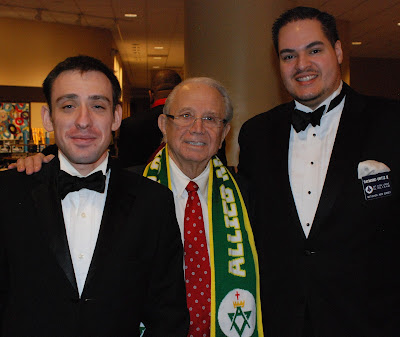 |
Courtesy Greg Knott
Bro. Eric Diamond |
Tyler Anderson
Christian Christensen
Patrick Craddock
Moises Gomez
Cameron Poe
Christopher Rodkey
The Magpie Mason is an obscure journalist in the Craft who writes, with occasional flashes of superficial cleverness, about Freemasonry’s current events and history; literature and art; philosophy and pipe smoking. He is a Past Master of both The American Lodge of Research in New York City and of New Jersey Lodge of Masonic Research and Education 1786; and also is at labor in Virginia’s Civil War Lodge of Research 1865. He is a past president of the lamented Masonic Society as well.






 |
Courtesy Greg Knott
Bro. Eric Diamond |
 |
| Ken Davis, The Masonic Society’s new president, displays the ceremonial gavel he is about to present to his predecessor, Jim Dillman of Indiana. Jim has guided the Society through a period of creative growth that is about to blossom in ways that will compel the Masonic world to take serious notice of our various doings. Sorry for being vague, but the announcements of the new initiatives are coming soon. |
 |
| Oscar Alleyne |
 |
| Courtesy A&ASR Jacksonville |
 |
| S. Brent Morris, Grand Abbott of the Society of Blue Friars, welcomes BF No. 105, Michael Halleran of Kansas, to the Consistory. |
 |
| Jeffrey Nelson tries on the Grand Chancellor’s collar and jewel at the Grand College of Rites’ meeting of February 13. It looks good! That’s retiring Grand Chancellor Lawrence Tucker at right. |
 |
| The 2016 Grand Council of Allied Masonic Degrees of the United States of America. |
 |
| MV Prince Selvaraj of Ontario and MV Doug Moore. |
 |
| Bro. James, secretary of the unfortunately named Illuminati Council in Illinois, presents outgoing Grand Master Doug Moore with honorary membership in that AMD council. |
 |
| RV Mohamad and MV Doug. |
 |
| The irrepressible Reese Harrison of Texas. |
 |
| I check into my room, go to the window to see what view there might be, and am confronted with multiple Templar crosses etched into the glass! Coincidence or Masonic conspiracy?! |
 |
| TMS Founding Members بافين دن. and Reed Fanning. |
 |
| Reed and Prince Selvaraj of Ontario. |
 |
| Michael, and TMS Members Ted and Ray. |
 |
| TMS Founding Member Roberto and TMS Fellow Paul. |
 |
| Although Stephen Dafoe quit the Masonic fraternity some years ago, he is missed, and his presence is felt still. |
 |
| Ted is the unofficial Masonic Week photographer. |
 |
| Mohamad and Aaron in AMD regalia. |
Copyright © 2008-25. All rights reserved. No part of this website (text, graphics, sounds or images) may be copied, reproduced, distributed, republished, downloaded, displayed, posted, or transmitted in any form or by any means, including, but not limited to, electronic, mechanical, photocopying, recording, mirroring, or otherwise, without the prior express written permission of the copyright holder, who can be reached by leaving a note in the comments section.
If you are stealing content from this website, you ought to stop and consider who you are and what you are doing.